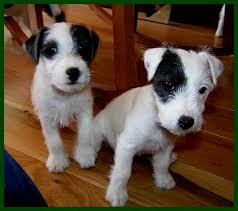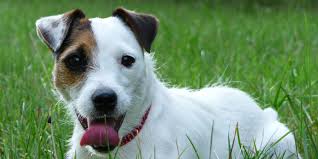Parson Russel Terrier
General
This breed originated in Devonshire, England during the 1800's. Interestingly enough, the Parson, Jack Russell and Russell terrier breed are 3 different breeds, and all named after the Rev. John 'Jack' Russel. Rev. Russel was an avid fox hunter and went on to breed them.
The Parson is a tough little dog that is fast enough to follow the hounds on a hunt, and fearless enough to dig into a fox hole and flush the fox from its lair - it is, like most terriers, incredibly tenacious.
As long as it receives enough physical stimulation this is a lovely little dog and makes a good family dog. The Parson Russell Terrier is a pleasant companion when it is sufficiently exercised; however if it does not get enough, it may become a nuisance. Your dog needs to be taken on a long, daily, brisk walk. In addition, he will be in his glory with space to run, hunt and play.
This breed originated in Devonshire, England during the 1800's. Interestingly enough, the Parson, Jack Russell and Russell terrier breed are 3 different breeds, and all named after the Rev. John 'Jack' Russel. Rev. Russel was an avid fox hunter and went on to breed them.
The Parson is a tough little dog that is fast enough to follow the hounds on a hunt, and fearless enough to dig into a fox hole and flush the fox from its lair - it is, like most terriers, incredibly tenacious.
As long as it receives enough physical stimulation this is a lovely little dog and makes a good family dog. The Parson Russell Terrier is a pleasant companion when it is sufficiently exercised; however if it does not get enough, it may become a nuisance. Your dog needs to be taken on a long, daily, brisk walk. In addition, he will be in his glory with space to run, hunt and play.
Is this the right dog for you?
A lovely little dog, but it is very high energy and if it does not receive sufficient mental and physical stimulation can become bored and frustrated and behaviours such as excessive barking, digging and destruction can occur.
They can be barkers as mentioned above, and it is always a good idea to teach the Bark and Shush
exercise right from when a pup.
This dog was born to chase and dig and this is something that all terriers, on average are very proficient at! If considering this cute little chap, then do invest in making a Digging Pit in your garden. Very simple to make and can save your flower beds and grass.
Where training is concerned, they are bright and not hard to train, however, they can be stubborn and wilful and do better with somebody that has experience with dogs, otherwise the dog may start training the owner! The best way to train them is with positive reinforcement methods and rather than a long training session, have several shorter one's and mix this up with some fun.
This is not the dog to leave alone at home all day. He requires interaction with his family. It is always a good idea to teach Alone Time training, so that separation anxiety does not develop.

Should you have 2 of the same, or 2 pups together?
No, as cute as this breed is, they are very often better by themselves as they do tend to be aggressive and dominant to other dogs, especially ones of the same breed. If you are going to have another dog with this breed, then you are better to look at something totally different, such as a Border collie, of opposite sex.
When it comes to which sex get on better, your best bet is one male and one female (both sterilized), or 2 males together. Never two females. The vast majority of the time two females will get on well until about 8 - 9 months of age and thenm fighting for position tends to occur. When males have the odd altercation, it tends to be over quickly, but with females, it just intensifies and often the only solution is for one of the females to be rehomes. This is not just for this breed, but in general.
Having two pups from same litter is not a good idea. Most people think that the pups will be happier with a playmate and won’t fight if they are family.Your pup should be at least 5 months old, before you consider bringing in another pup. This allows the pups to grow to their full potential and not become over dependent on one another. The truth of the matter is that your two pups are likely to:
Bond with each other to the exclusion of you
No, as cute as this breed is, they are very often better by themselves as they do tend to be aggressive and dominant to other dogs, especially ones of the same breed. If you are going to have another dog with this breed, then you are better to look at something totally different, such as a Border collie, of opposite sex.
When it comes to which sex get on better, your best bet is one male and one female (both sterilized), or 2 males together. Never two females. The vast majority of the time two females will get on well until about 8 - 9 months of age and thenm fighting for position tends to occur. When males have the odd altercation, it tends to be over quickly, but with females, it just intensifies and often the only solution is for one of the females to be rehomes. This is not just for this breed, but in general.
Having two pups from same litter is not a good idea. Most people think that the pups will be happier with a playmate and won’t fight if they are family.Your pup should be at least 5 months old, before you consider bringing in another pup. This allows the pups to grow to their full potential and not become over dependent on one another. The truth of the matter is that your two pups are likely to:
Bond with each other to the exclusion of you
- Will stress without the other dog being around
- Fight with each other
- Be more destructive and boisterous
- Two pups together often leads to one being more assertive and the other more submissive. This could well end up in a situation where the more submissive dog will never develop its full potential.
- Mature later
Do they get on with other dogs?
This is a breed that needs extensive socialization as a pup and ongoing. Even with early and continued socialization, the terrier can be very otherwise towards other dogs, and all that is needed is for the Parson to think that the other dog looked at him in a threatening manner. They have no fear and will easily take on a much larger dog.
Do they get on with other dogs?
This is a breed that needs extensive socialization as a pup and ongoing. Even with early and continued socialization, the terrier can be very otherwise towards other dogs, and all that is needed is for the Parson to think that the other dog looked at him in a threatening manner. They have no fear and will easily take on a much larger dog.
Do they get on with other animals?
Even with early socialization this can be a problem. This breed has a very high prey drive and smaller animals not recommended at all.
Even with early socialization this can be a problem. This breed has a very high prey drive and smaller animals not recommended at all.
Are they good with children?
This breed is known to be good with kids overall, however, they will not tolerate rough treatment from toddlers and young kids. They can play for hours with children as long as you are throwing something and the dog is retrieving.
As with all dog, the dog should be socialized with kids from being a pup, and this socialization kept going. By the same token, children should be taught how to approach and interact with dogs and treat them with respect.
4 starsGood with Kids: This is a suitable breed for kids and is known to be playful, energetic, and affectionate around them.
This breed is known to be good with kids overall, however, they will not tolerate rough treatment from toddlers and young kids. They can play for hours with children as long as you are throwing something and the dog is retrieving.
As with all dog, the dog should be socialized with kids from being a pup, and this socialization kept going. By the same token, children should be taught how to approach and interact with dogs and treat them with respect.
4 starsGood with Kids: This is a suitable breed for kids and is known to be playful, energetic, and affectionate around them.
Health
This breed may be prone to glaucoma, deafness, Legg-Perthes disease, glaucoma, ataxia, deafness, patellar luxation and lens luxation.
“In today’s age, with the rising cost of veterinary care, it really is a wise decision to consider medical insurance for your pets. Depending on the plan you choose, you can ensure that if your pet does develop one of the health issues the breed is prone too, that you will be covered –additionally, just knowing that any accident your pet may have will be covered, will out-weigh the monthly insurance fee for most pet owners. Our own personal choice is Genricpet as they have a ‘no limit’ policy and their rates are comparable to the rest of the industry. To find out the questions and things to look for in a Medical Insurance, please just follow this link”
This breed may be prone to glaucoma, deafness, Legg-Perthes disease, glaucoma, ataxia, deafness, patellar luxation and lens luxation.
“In today’s age, with the rising cost of veterinary care, it really is a wise decision to consider medical insurance for your pets. Depending on the plan you choose, you can ensure that if your pet does develop one of the health issues the breed is prone too, that you will be covered –additionally, just knowing that any accident your pet may have will be covered, will out-weigh the monthly insurance fee for most pet owners. Our own personal choice is Genricpet as they have a ‘no limit’ policy and their rates are comparable to the rest of the industry. To find out the questions and things to look for in a Medical Insurance, please just follow this link”
Do’s and Dont’s
Do’s
Don’t
Do’s
- Do get your pup from a KUSA registered breeder and do read the articles on Breeders and also choosing a pup
- Sterilize at approximately 6 months of age.
- Do take your pup for socialization - pups should start at 8 weeks of age and this should not be missed - lays the foundation for future social interactions.
- Do continue the socialiazation - keeps solid social skills in place
- Give daily, regular exercise which this breed really needs.
- Supply chew toys and mental stimulation when left alone.
- Allow your dog to be part of the family
- Give regular brushing and annual vacs.
- Supply mental games such as behaviour games, scenting games etc in the garden to mentally stimulate this breed.
- Take your dog for basic training and keep simple house rules in place
- Do be very careful introducing this breed to other dogs.
- Do supply this dog with a Digging Pit to satisfy the digging instinct.
Don’t
- Leave them off-lead unless area fenced.
- Don't use aversive training methods.
- Leave this breed outside alone – behaviour problems will develop


